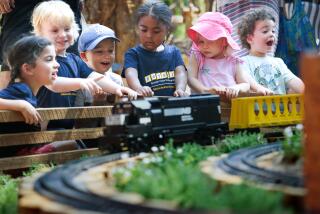Volunteers Strive to Restore 95-Year-Old Steam Engine : History: They work in an outdated technology in hopes of making the locomotive chug again.
- Share via
SANTA CLARITA — As he has virtually every weekend for the past five years, Norm Harris of Newhall spent a few hours on a recent Sunday morning at the Saugus train station.
Harris, 53, dons heavy work gloves and hammers away at a 95-year-old air compressor, the device that controls a locomotive’s brakes. The chunk of machinery is larger than most car engines and is vastly different from what he works with as an engineer for Hughes Aircraft.
The task at hand: The compressor’s valves are jammed. They have to move to work the brakes of the Mogul 1629 steam engine that Harris and a handful of other volunteers are laboring to restore for the Santa Clarita Valley Historical Society.
“Taking it apart without damaging it is the difficult part,” said Harris. “What slows you down is that this technology is being lost. You don’t have the tools. You have to make do.”
Making do is what Harris and other volunteers have done throughout this project, using a mixture of brute strength, technical expertise and mechanical improvisation.
They have no money--certainly not the $300,000 that it would take to professionally refurbish the train engine.
They have limited manpower. A small billboard was posted on San Fernando Road earlier this year, asking anyone familiar with steam locomotives to call them. (No one has.)
They have the challenges inherent with a 75-ton locomotive.
“When I worked in aerospace, everything was built to be light,” said volunteer Leslie Bedding, who is retired. “With these, it seems everything was built to be heavy.”
Fortunately, they have an abundance of patience and enthusiasm that recalls the optimistic era that gave rise to the steam engine.
For these men, the chance to see this grand old machine chugging along the tracks of William S. Hart Park is worth the hundreds of hours of manual labor and the frustration when their try-and-see mechanical solutions fail. They are living out the life-sized dream of every model railroader.
“It’s really very exciting to people interested in railroads to get a classic machine like this running,” Harris said.
Bedding is more succinct: “It’s going to be a great day.”
The engine was built in 1900 by the American Locomotive Co. in New York and once ran on Santa Clarita’s Southern Pacific railroad line for trips to Arizona and Oregon.
These days, the locomotive’s black, steel body is bleached gray in some areas and rusted brown in others. During the process of restoration, the engineer’s cab has been removed and the train’s boiler has been gutted of its original piping.
Even its bell has been removed--stored for safe keeping.
“One of the depressing things is that lately we’ve been taking more pieces off of it than putting on,” admitted Bedding. “When I first got here, it was all together. Now it looks like a derelict.”
The 75-year-old Castaic man has donated time for the past four years, and finds the work an interesting contrast to what he once did as a quality-assurance inspector in the aerospace industry.
“It’s rewarding because of what’s going to come from it, ultimately,” said Bedding. “It’s something old we’re trying to save so other people can take advantage of it. Especially the younger people.”
If successfully restored, the Mogul 1629 will be one of only a few steam locomotives operating in California and about 50 nationwide, said Kay Carter, executive director of the San Diego Railroad Museum.
“These are very old pieces of equipment,” Carter said. “There are not too many left that can be put in running condition.”
For now, volunteers are happy to have overcome another hurdle.
After repeatedly pounding blocks of wood into the air compressor, its valves have begun to shift a few inches.
They leave the compressor to cool, confident they can get the valves to move more easily the next Sunday.
A small victory, maybe, but one that allows them to continue working. That’s all these volunteers have ever really asked to do.
“We’re only going to be as far along as we’ve got people,” said Bedding. “It’s a labor of love.”
More to Read
Sign up for Essential California
The most important California stories and recommendations in your inbox every morning.
You may occasionally receive promotional content from the Los Angeles Times.













